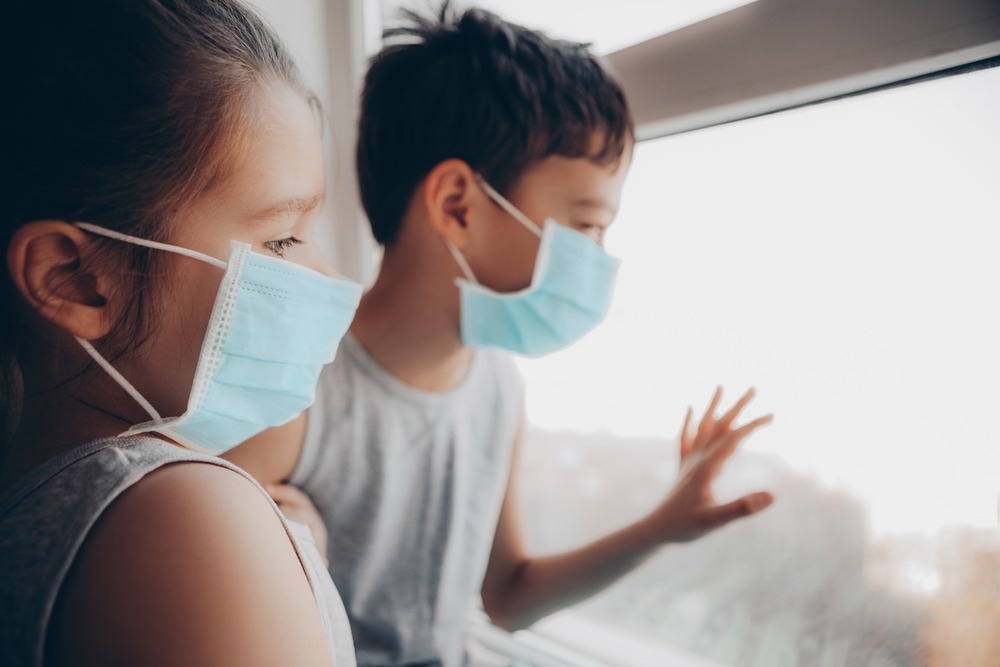A recent study published in Frontiers in Neurology found that the most common long COVID symptoms in the pediatric population showed a higher prevalence among patients in the age range of 6-17 years and were identical to those reported in adults. Although the neurological manifestations of post-COVID syndrome faded over time, the psychological impacts persisted, and more so, in patients between 6-17 years of age.

Background
The coronavirus disease 2019 (COVID-19) pandemic caused by severe acute respiratory syndrome coronavirus 2 (SARS-CoV-2) has claimed over 6.5 million global deaths. Italy was among the worst impacted countries and witnessed a high mortality rate.
The virus causes systemic inflammation and neurological dysfunctions and neurophysiological alterations that cause various psychiatric disorders like anxiety, depression, obsessive compulsive disorder (OCD), post-traumatic stress disorder (PTSD), and decreased cognition. Additionally, the infection precipitates somatic symptoms like body aches and respiratory distress, as well as neurophysiological alterations, for example, disruption of the circadian rhythm, attention deficit, irritability, and fatigue.
The symptoms post-SARS-CoV-2 infection can last for extended periods. Symptoms persisting for more than three months after the infection are collectively referred to as post-COVID syndrome or long COVID.
Various post-COVID syndrome manifestations have been studied in adults, adolescents, and pediatric patients. However, systematic results of long COVID among adolescents and pediatric populations are limited.
The study
This study aimed to detect the occurrence and type of long COVID symptoms 3-5 months post-COVID in the pediatric population for comparison with previously reported post-COVID syndrome symptoms in children and adults.
The study was based on the hypothesis that neurophysiologic post-COVID syndrome symptoms lead to psychological effects that interferes with normal adaptability.
This study was conducted in Italy between February and November 2021. The cohort comprised 322 individuals, 1-17 years of age, with past COVID-19. Neurophysiologic conditions were assessed at one month and 3-5 months post-COVID, based on a checklist for COVID-19 symptoms. Additionally, long COVID symptoms were evaluated through psychological questionnaires – completed by the children and their parents. The results were then statistically analyzed.
Results
At the onset, 60% of the participants presented with COVID-19 symptoms. The rest of the participants were asymptomatic at infection-onset. After one month, 20% of the patients had symptoms, while after 3-5 months, 22% of patients showed symptoms.
The symptoms varied at different time points. The most prevalent symptom at infection-onset was headache which persisted even after 3-5 months, although at a lesser frequency. Fatigue and anosmia were also seen 3-5 months after COVID-19 infection. Ageusia was present at the onset of the disease, which increased at 3-5 months post-infection after a regression at 1 month.
Neurophysiological symptoms of long COVID, like headache, ageusia, and fatigue, were more prominent in patients between 6-17 years of age. These symptoms were rarely present in children below five years of age. Musculoskeletal pain and anosmia exclusively occurred in 6-17-year-olds. Alterations in eating habits, changes in the circadian rhythm, cognition and behavior, and increased use of electronic gadgets were also documented.
In the 6-17-year-old age group, disruption in the circadian rhythm, dietary alterations, behavioral problems, cognitive changes, and increased use of technological gadgets were reported. The same changes were recorded in 1.5-5-year-old children, though with lower incidence rates.
Among the psychological manifestations of long COVID, based on the child behavior checklist (CBCL) questionnaire answered by the parents, some children between 1.5-5 years of age scored above average for anxiety/depressive symptoms, emotional reactivity, sleeping problems, closure, and attention problems. Of note, internal problems were greater compared to external problems.
Parents of more than half of the children in the age group 6-17 years reported deteriorations in the overall activity of their children – with respect to their academic performance, recreational activities, and social competence. Among the 1.5-5-year-old age group, more internalizing problems were reported. In this group, anxiety was the most common problem, followed by depression and closure, somatic problems, problems with cognition, and oppositional issues.
To assess depressive-anxious symptoms, the children aged 6-17 years were divided into a subgroup of 8-16-year-old. The Multidimensional Anxiety Scale for Children-2 Self Report (MASC 2-SR) questionnaire rendered an above-average score for social and performance anxiety, followed by feelings of humiliation and rejection. Other than generalized anxiety, separation anxiety, obsessive-compulsive symptoms, and fear of danger was also described. These children also scored high in tension and panic – the physical manifestations of anxiety.
The Children's Depression Inventory (CDI-2 SR) questionnaire revealed negative self-esteem, mood, and physical symptoms. Many experienced functional problems with problem interpreting and feeling ineffective. On comparing long COVID with anxiety scores, post-COVID syndrome exhibited significant correlations with obsessive-compulsive symptoms, social anxiety, and generalized anxiety.
The Trauma Symptom Checklist for Children-A (TSCC-A) questionnaire was used to study post-traumatic symptoms. Before answering this self-assessment questionnaire, parents were enquired whether their children faced any traumatic situation immediately before the infection and during or post-infection. Few patients had high scores on this scale. Dissociative symptoms were also noted, with few showing overt dissociations and some presenting with hidden dissociation. Depression, anxiety, and anger associated with trauma were also detected.
Analysis of the results revealed significant correlations between post-COVID symptoms and scores of dissociations, PTSD, anger, and depression. No significant association was found between the questionnaire scales and parent-reported traumatic events.
Conclusion
Common long COVID symptoms of pediatric patients were similar to those of older patients. Although the occurrence of common long COVID symptoms was higher in adults and the elderly, the psychological manifestations seemed to persist longer in children (6-17 years old). Meanwhile, the neurological symptoms decreased over time in the pediatric population. Further studies exploring the relationship between long COVID and neuropsychiatric symptoms are warranted to plan to prevent chronic symptoms post-COVID.
- Guido, C. et al. (2022) "Neurological and psychological effects of long COVID in a young population: A cross-sectional study", Frontiers in Neurology, 13. doi: 10.3389/fneur.2022.925144. https://www.frontiersin.org/articles/10.3389/fneur.2022.925144/full
Posted in: Child Health News | Medical Science News | Medical Research News | Disease/Infection News
Tags: Adolescents, Anosmia, Anxiety, Children, Chronic, Circadian Rhythm, Coronavirus, Coronavirus Disease COVID-19, covid-19, Depression, Fatigue, Frequency, Headache, Inflammation, Mortality, Musculoskeletal, Neurology, Obsessive Compulsive Disorder, Pain, Pandemic, Post-Traumatic Stress Disorder, Respiratory, SARS, SARS-CoV-2, Severe Acute Respiratory, Severe Acute Respiratory Syndrome, Stress, Syndrome, Trauma, Virus

Written by
Nidhi Saha
I am a medical content writer and editor. My interests lie in public health awareness and medical communication. I have worked as a clinical dentist and as a consultant research writer in an Indian medical publishing house. It is my constant endeavor is to update knowledge on newer treatment modalities relating to various medical fields. I have also aided in proofreading and publication of manuscripts in accredited medical journals. I like to sketch, read and listen to music in my leisure time.
Source: Read Full Article
